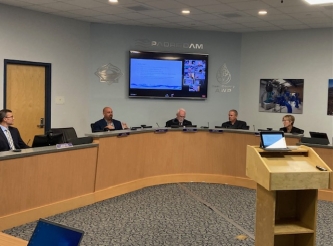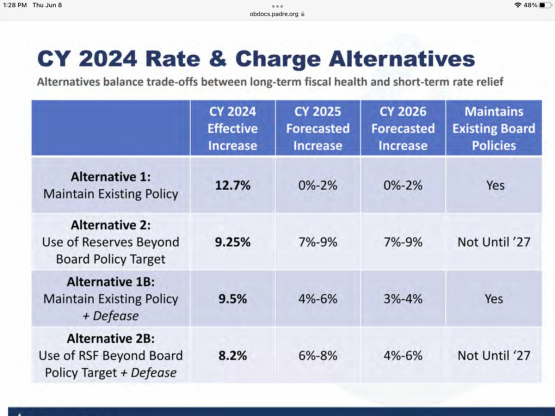Original Article: Click Here
By Mike Allen

June 9, 2023 (Santee) — Padre Dam Water District’s board is fed up with having to pay higher rates for the water it purchases from the San Diego County Water Authority, and voted unanimously not to go along with any rate hike unless the CWA gets serious about its long-range planning.
The five-member board took the vote after listening to a presentation by CEO Kyle Swanson (photo, right)about CWA raising the wholesale rate charged to member water agencies next year by a range between 8.2 to 12.7 percent. At one point, CWA was considering increasing to about 13 percent, but the range is ever-changing and unknowable at the current time, Swanson said.
Several board members said they were upset over the four alternatives presented, especially after Padre Dam made a five-year commitment to keep its water rates flat.
“I have absolutely zero confidence in their zero to two percent projection (in one alternative),” said President Bill Pommering. “They’re not projecting properly. This board, which has worked so hard and diligently, was able to come up with a five-year plan where we’re not taking any internal rate increases. Unfortunately, we still have to pass on and there’s no way to avoid the rate increase from the County Water Authority and that’s a huge number and believe me, most people are going to come back and (say) that’s something we did. It isn’t.”
Last year Padre Dam used funds it obtained from a legal settlement to offset the increased costs for water it buys from the CWA as well as rate hikes by SDG&E to keep local water rates stable through the end of June.
But starting July 1, PDWD customers will see their water rate jump three percent as the subsidies expire. For those customers who live in higher elevation areas like Alpine, rate hikes by SDG&E will push their bills up so that a typical user will see at least a $5 increase in their monthly bill, according to data supplied by Padre Dam.
According to a survey done by the Otay Water District last year, Padre Dam has the highest water rates in San Diego County with an average monthly bill of $136.98 based on 2021 data. The next highest was Ramona Water District at $121.41. Those figures don’t include sewage costs, which are often higher than water.
Padre Dam Director Brian Fordyce said while he wasn’t in favor of any rate increase, the reality is that there will be one.
“The real issue isn’t the rate increase we’re talking about today. The real issue is there is no plan, and these rate (increases) are going to continue every single year. I believe we’ll be sitting here in a year, and will be looking at 12 or 13 percent (increase) no matter what happens today unless some plan gets put in place.”
The CWA board has signaled through earlier meetings that it will likely use its reserve balance to offset the higher costs of the imported water it receives from Los Angeles-based Metropolitan Water Authority. Those reserves have dropped to about $100 million today from about $400 million held in 2014, according to a Los Angeles Times report.
That caused concern by some board members that the depleted reserves could have a deleterious impact on the agency’s ability to pay past debts and impede borrowing for future projects.
Director Suzanne Till said complicating the issue is the fact that Padre Dam and other local water agencies are building major water reclamation projects that will result in not having to buy as much water from CWA.
Till and other directors noted that CWA is locked into long term contracts called “take or pay” that make no sense given the market realities today. For instance, the CWA has a contract to buy desalinated water from Poseidon in Carlsbad through 2045 at $2,800 per acre foot (about 326,000 gallons). Last year CWA was selling treated water to members agencies at about $1,800 an acre foot.
All 24 water agencies belonging to CWA are using less water as prices continue to rise and people conserve more. But because they’re using less, agencies are collecting less revenue.

And yet, due to inflation and rising costs, the water agencies are forced to increase their rates,Till said.
“We’ve got to get out of the vicious cycle of the water use going down, and yet our rates are going up,” she said.
Swanson said the CWA is projecting ever increasing water use over the next several years but that doesn’t make sense given that water reclamation projects like the East County Advanced Water Purification Program and Pure Water in San Diego will begin producing more local water, thus reducing demand for CWA’s wholesale water.
In his letter to CWA objecting to the proposed higher rates for the next two years, Swanson said it is unlikely that local demand will increase by 10 percent over the next five years.
“What is more likely is that the expected growth in demand will not occur and CWA member agencies will continue to experience double digit increases unless significant adjustments are made,” Swanson wrote.
He offered several strategies that CWA could follow to reduce its costs including deferring non-critical capital improvements such as the San Vicente Pumped Storage project until grant funding is secured; cutting or delaying adding staff positions; reducing the debt service ratio; and finally, providing a five year forecast instead of the current three year model.
The CWA board is expected to take up the issue of its wholesale rate increase at its June 22 meeting.
